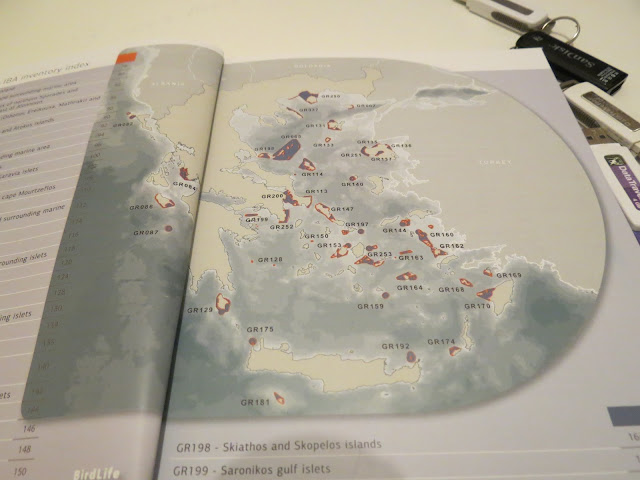June 12th 2013
A new book depicts a research and conservation success story for Greece. Its a product of a recent Life Project but it carries the weight of a long-term research survey journey through the many and varied coasts of this country. It all started in 1995; at the time nobody could ever have thought that the Hellenic Ornithological Society (HOS) could discover Greece's hidden pelagic bio-treasures. Well, it did.
I was privileged enough to be on board the first seabird expeditions; we made amazing finds.
Many threatened birds use the islands as refuges. Where we intially thought we had only a few dozen Audouin's Gulls we soon found over 700 pairs! Shearwater and falcon colonies, migration "fall outs" isles, songbird breeding communities.... And its not just birds. Its many, many little pieces of untouched paradise. Few had ever thought of protected "parks" here. An incredible number of unique biodiversity sites were identified in this work; they became the initial backbone of the insular Natura 2000 protected areas network of this country. Dozens of new protected areas were founded through the work of one organization, the HOS. That's the success story. Now this book adds yet more knowledge and cartography: proposed protected delineation through the concept of marine Important Bird Areas (marine IBAs). 41 outstanding areas are identified, assessed, mapped and scientifically presented.
The book is a tribute to the exploratory and conservation spirit of HOS. It was written by my friends Jacob Fric, Danae Portolou, Aris Manolopoulos, and Thanos Kastritis. Many more have contributed to the book and also through several previous projects that supported the work. The book is very well written and will please the "little scientist" inside every reader. I am particularly fond of the design aspects, they are excellent - an in-house labour of love. Its a beautiful scientific book! ...an enticing journey for any lay-person or naturalist interested in Greece.
Now, the sad thing is that many of these important bird areas are threatened! The pressures are diverse and varied: New wind farm projects atop rock islets, sprawling tourist developments, selling-off of entire islands; new recreational activities and many many sea vessels everywhere (bringing with them rats!) and more.... and ofcourse the issue overfishing and illegal fishing making the seas go "life-less". An amazing challange. I hope people become inspired...
And one last thought.
Through this small blurb I want to thank my friend Costas G. Papaconstantinou who helped HOS in outstanding ways to begin, strategise and lead the seabird researches and protected-area creation campaigns. Costas gave me my first job in Greece when I stepped off the plane from Canada in the Spring of 1995. He had found private funding for us to "go on a fishing boat to survey all the islands of the Eastern Aegean...". His interest in the blue wilderness excited me, but it puzzled me: There was so much to do in Greece, so much uncharted ground for conservation on the mainland. I thought: "Why go there? The islets are practically "protected" by their desolation". I was wrong. How else would we have dozens of new protected-areas without these first exploratory surveys? It was not long that a lot of these unknown areas became "threatened areas". And today we should be fighting to save these islets and seas, many of which are now "legally" protected - but only on paper!
The fight for conservtion at sea is continuing in NGOs, governments and research institutions in Greece and the EU, and the HOS is spearheading this growing movement. Lets help.
Check out: www.ornithologiki.gr/en/seabirds
 |
| The 41 marine Important Bird Areas identified in the book: Lets save them! |


























